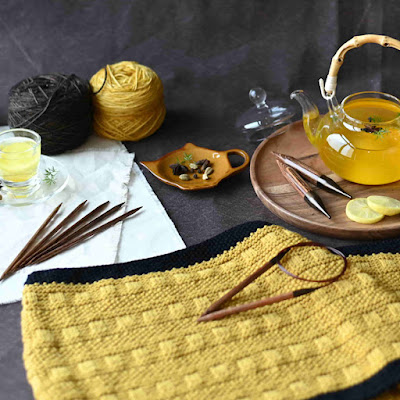Entrelac knitting is a fascinating technique that creates a unique, woven, or basket-weave effect in your fabric. The texture looks like a diamond pattern. In this process, you knit small blocks of fabric with knitting needles that interconnect at a diagonal and give the appearance of interlaced knitting strips. It may look complex to beginners, but the method is straightforward and becomes easy after continuous practice. This blog will guide you about entrelac knitting, the steps to create it, and helpful tips for getting the best result.
Are you ready to learn this interesting technique? Yes, great!
What do you understand by entrelac knitting?
Entrelac knitting is an innovative and advanced technique that produces diamond-like patterns by knitting rows of blocks or rectangles in different directions. This technique works in short rows and can be done using one or more colors. You get a 3D shape that looks visually appealing and involves various steps and each step is easy to learn.
What skill do you need for entrelac knitting?
While the Entrelac technique looks complex, it is fairly easy to create. If you are an expert on a pair of circular needles, it is straightforward once you understand the instructions and pattern. You must have a basic understanding of knitting stitches such as cast-on, knit, and purl stitch. Other than these, you need:
- Must be aware of k2tog, and p2tog (knit or purl two stitches together).
- The technique of pick-up stitches is required to create a woven appearance of interconnected blocks.
- Entrelac follows entirely a garter pattern, although stockinette stitches are commonly used.
Which knitting needles are the best for entrelac technique?
Many options are available, but choosing the best is a daunting task. So, let’s discuss them all:
- If you want to create small entrelac projects in rounds such as hats or socks double pointed needles are good to work with.
- Single-pointed knitting or straight needles are ideal for smaller to medium-sized projects like dishcloths, blankets, or sweaters. As you know, these fabrics produce dense fabric, which may strain on hands and wrists.
- Circular knitting needles are the best option as they allow, you to knit on flat and round pieces. Furthermore, you can hold a large number of stitches easily. With the advantage of interchangeable needles, you can adjust the cable size according to your project.
Why try Entrelac knitting?
- It adds a striking visual effect, making it different from the traditional method of knitting.
- You can experiment with contrasting yarns, which is great for colorwork technique.
- The versatile technique works for projects such as scarves, sweaters, blankets, and shawls for beautiful textures.
Entrelac knitting- key concepts
Before learning this technique, let us understand a few terms used in this method.
- Base triangles are the foundation of entrelac knitting. It is created at the bottom edge of the fabric.
- Once you finish the base triangle, knit left-leaning rectangles to begin the next tier.
- These right-leaning rectangles slant in the opposite direction, created in alternating tiers.
- At last, you create a top triangle, called a finishing triangle, that is essential to create a smooth edge at the top of the project.
Entrelac knitting – Step-by-step procedure
To start the method, knit a series of triangles to create a foundation.
Step 1: Start with cast-on stitches
- Cast on at least 20 stitches using cast-on methods. You choose any technique like longtail.
Step 2: Create a base triangle
Row 1 (right side): knit 1 stitch and turn your work. Use the back-and-forth technique in short rows so you won't complete the entire row.
Row 2 (wrong side): Purl the knit stitch, then turn work again.
Row 3 (right side) Knit 2 stitches (knit the original plus one more stitch), and turn your work.
Row 4 (wrong side): Purl those 2 stitches and turn your work.
Row 5 (right side): Knit 3 stitches (knit the original plus one more stitch), and turn your work.
Continue this pattern across all the cast-on stitches, until you reach the end. This forms the base triangle.
Step 3: Repeat for additional triangle
- After completing the first base triangle, work on the same needle, without cutting the yarn.
- Start with the next triangle by following the same method as in step 2.
Step 4: Right slanting triangle
- For clean and neat edges, begin the second tier on the wrong side, if you knit flat, avoid extra yarn tails.
Step 5: Pick up stitches
- Pick up the stitches with a knitting needle along the edge of the base triangle.
Step 6: Third tier (left slanting triangle)
After completing the right slanting triangle, the next step is to work on the left.
- Start at the right edge and pick up 5 stitches.
- Work in short rows and purl back.
- Turn your work purl at the end of the work and repeat the process.
- Continue until you have worked all the stitches into the rectangle. Repeat this step up to the last stitch.
Tips for successful entrelac technique
- Use stitch markers to keep track of your patterns.
- Work on the swatch before you start working on the final project.
- For neat edges, pick up stitches from the front.
Entrelac technique may be complex for beginners, but once you break down the methods into steps, you will love, and enjoy doing this. Whether you are working on a small or a large project, it allows you to create a beautiful textured fabric that stands out. So, grab your yarn and knitting needles and dive into the entrelac technique.
Happy Knitting!














